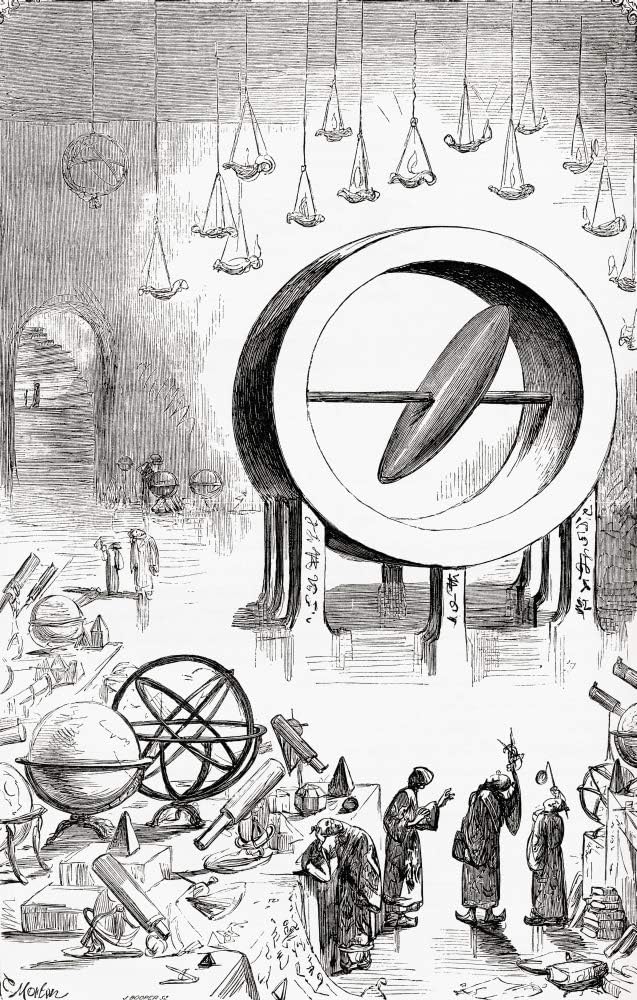
For my short story The Waves on Mars are Really High, I borrowed an idea from Jonathan Swift’s Gulliver’s Travels: the floating island of Laputa, powered by the mythical substance adamant.
The Floating Island of Laputa
Swift recorded in Gulliver’s Travels that the floating island of Laputa was 7837 yards in diameter and 300 yards thick, and rested on a plate of adamant, 200 yds thick.
At the centre of the island there was a hole, about 50 yards in diameter, where the island’s astronomers descend into a large dome. It was situated about 100 yards beneath the upper surface of the plate of adamant.
Navigation by Adamant

The navigation and motion of the island is controlled by a massive magnetic loadstone, in the shape of a weaver’s shuttle. It was six yards long and in the thickest part, three yards wide
This loadstone was held by a very strong axle of adamant passing through its middle, around which it moved. It was so well balanced that the lightest touch would turn it.
It was hooped round with a hollow cylinder of adamant, four feet deep, as many thick, and twelve yards in diameter, placed horizontally, and supported by eight adamantine feet, each six yards high. In the middle of the concave side, there is a groove twelve inches deep, in which the extremities of the axle are lodged, and turned round as there is occasion.
Because the hoop and its feet are one continued piece with that body of adamant which constitutes the bottom of the island, the stone could not be removed by any force,
By changing the direction of the loadstone, the island is made to rise and fall, and move from one place to another.
Swift’s Moons of Mars
Swift recorded that the astronomers who live on the floating island of Laputa had observed that Mars had two moons and named them, Phobos (fear) and the other Deimos (horror).
This was surprising as the moons of Mars were not discoverd until 1874 by Asaph Hall, almost 150 years after Swift wrote his book,
Swift also records that Laputa’s astronomers had calculated that the orbiting distances of the two moons were 3 and 5 Martian diameters and periods of 10 and 21.5 hours.
Their actual orbital distances are approximately 1.4 and 3.5 Martian diameters, and their respective orbital periods are 7.66 and 30.35 hours.
Not very close, but sufficiently close to generate lots of speculation that Martians came to Earth in the 18th century and visited Swift.
Adamant: Diamond, Lodestone, and Folklore
Adamant is thought to be archaic form of diamond. The English word diamond is believed to be derived from adamas, via Late Latin diamas and Old French diamant.
In the Middle Ages adamant also became confused with the magnetic rock lodestone, and a folk etymology connected it with the Latin adamare, ‘to love or be attached to’ Another connection was the belief that adamant (the diamond definition) could block the effects of a magnet. This was addressed in chapter III of Pseudodoxia Epidemica, for instance.
The Waves on Mars are Really High,
In my story, the reluctant time travellers, James and Elizabeth, attracted by excellent cakes in the window of a patiserie, are trapped by an ancient time traveller who transports them to Mars in the distant past when most of the northen pole was covered in sea and before the Tharsis volcano had formed.
After meeting the time traveller again on a ship on the Martin sea, they find themselves on a floating island battling meteors on a strange floating island powered by a machine made of adamant.
James and Elizabeth eventually master the controls of adamant machine and are able to stop the meteor attack, but not before Mars is irreparably damaged and the sea, through fissures in the surface drains underground.
The Waves on Mars are Really High can be found in my anthology, The Webs of Time, available on KIndlw and paperback
